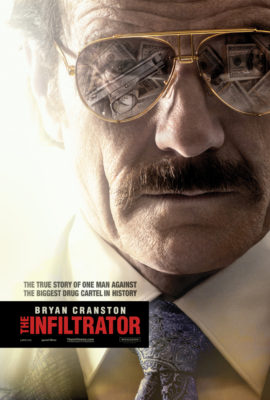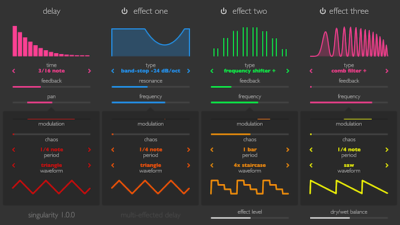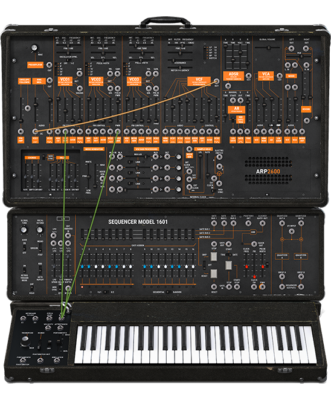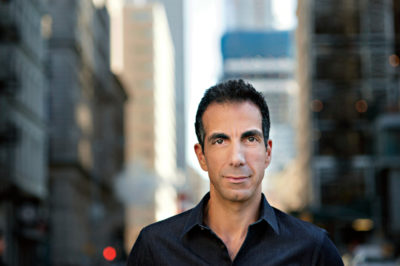Studio Solutions: Score Problem Solving for “The Infiltrator”
For all those who can’t get enough of the master actor Bryan Cranston since the finale of “Breaking Bad,” this week brings excellent news: He’s starring in The Infiltrator, based on the true story of a U.S. Customs official who uncovers a money laundering scheme involving Colombian drug lord Pablo Escobar.
The gripping tale, which hits theaters July 13th, also was a harbinger of good news to Chris Hajian, who won the coveted position of scoring the latest film from director Brad Furman (The Lincoln Lawyer, Runner Runner). The New York City-based composer wasn’t tasked with doing anything average for this sonic backdrop, however – he too would have to go in deep with The Infiltrator.
Charged with channeling the best of 1980’s-era soundtracks, and then updating that sound, Hajian had a delicious challenge on his hands. Working out of his Manhattan studio, the solutions began to reveal themselves: What one plugin set the tone for the entire soundtrack? What soft synths proved indispensable? And what classic sound source was absolutely NOT ALLOWED?
Read on to see how he solved the puzzle in unforgettable fashion. And what’s better, a lucky few SonicScoop readers will get to attend the Society of Composers & Lyricists NY (SCL NY) private screening of The Infiltrator on Tuesday, July 19th, followed by a Q&A with Hajian and the film’s music team. See full details at the end of the article, but infiltrate fast! Tickets are free, but limited to the first 10 people to RSVP.
Composer name: Chris Hajian
Composer Website: http://www.chrishajian.com
Studio location: Manhattan, NYC
Film: The Infiltrator – Brad Furman, Director; Starring Bryan Cranston, Diane Kruger, John Leguizamo, and Benjamin Bratt. Opens in Theaters Nationwide on July 13th.
Where to Listen: Preview the spine-tingling score here on iTunes.
Before the Score: I like to talk to directors in a broad way at first. I ask them about the tone and feeling they want from the score, even have them tell me what other scores they feel they connect to or feel is relevant musically for their film. Always talk story, emotion and the tone of the film.
Brad and I go way back and he trusts me creatively a lot so we didn’t need to go crazy with other references. We talked more about the story and the characters and what he hoped to convey through this film. We both wanted to create a core that had 80’s synth elements but for it to be combined with my writing esthetic.
That was the start. Then I developed the sonic landscape of my score. It had those elements with modern ambient textures and string emotional string melodies. What he didn’t want was anything cliche’ or obvious. There is also almost NO use of drums or percussion in my entire score! That was by design, we both felt that sound has been played a lot and wanted to try to create motion from synths and pulses and reverse effects.
He didn’t want the score to feel strictly like an ‘80’s score. He wanted it to have that flavor and sonic landscape but with my own esthetic. Also we looked at ‘80’s scores and there was a distinctly different style in how they approached the cues: First off there is less score in many of the films from that era. As well, the cues tend be longer and more linear. They didn’t really make all the perspective shifts that we are accustomed to today. I tried to use that tactic whenever was appropriate.
That ultimately lead to a healthy mix of synths, strings and acoustic guitar. I just kept digging into how far I could go with that sound palette, mocking up all the demos with samples to see how it was all fitting together. Ultimately I recorded a 30-piece string section, which was great!
The guitar only comes in during the very last cue and represents Bob’s (Brian Cranston’s character) re-connection with his wife and family. Kind off a new start and a re-buidling of his personal life and losing all his other persona’s behind. It just Robert Mazur and his wife.
My Rockin’ Room: Well, I work in Logic and have a huge sound library! I have a new MacPro that is loaded and totally decked out with RAM. I work with huge templates and in film you need so many sounds that I need a system that can handle huge sessions.
In The Infiltrator there are some sessions that have 80-90 software instruments! As a composer I go with my first instincts a lot, so it’s important I don’t get bogged down in the tech aspect when I’m composing.
That means my workflow is critical. My Tech God is Anthony D’Erasmo and he is brilliant at understanding my needs and making my life as easy technically as possible. He really understands how creative minds work and does everything he can to make my system run efficiently.
As far as ergonomics, I have a very streamlined set up. I like that! Also in my workspace I have a ton of light which I need! It keeps me going, and helps to keep me in a good state of mind and feeling inspired.
Studio Solution 1 — SINGULARITY:
My assistant and I, Tristan Clopet, worked a lot with Sinevibes’ Singularity to create this sound I wanted for the piano. I’m using the piano in a very abstract yet emotional way.
Singularity is a 4-step delay plugin that has a cumulative effect on the signal. It also has many creative options like granulator, filters/phasers, and a great frequency shifter that we used to create this eerie modulated piano sound. The director Brad Furman loved this sound and what it brought out emotionally! It was really inspiring to use!
Studio Solution 2 – ARTURIA SYNTHS:
I heard the Arturia stuff and just had to get it for this project. They sound fat and have character. They also are not pristine sounding which is authentic sounding to the actual analog synths.
I opted to go with programing the analog synths using this plugin because of how the schedule was going for the film. I was creating demos for months and there were so many changes and tweaks that I would never have been able to use only analog synths throughout this process. Every time there was a change and the cues needed to be tweaked and or re-written I would have to have had all those synths performed again and that was just too prohibitive from a scheduling and budget standpoint.
It worked out great as the ‘80’s sound that’s incorporated into my score is more in a hybrid style, so having the control of soft synths was necessary and the way to go for this project.
As far as specific synths in Arturia I leaned on the ARP 2600, Jupiter 8, Oberheim SEM and Prophet. They are all just awesome! Other synths I relied on were Signal, Diva by uHe, Alchemy, Giant Piano, Native Instruments, Massive, Omnisphere, Rev and a lot of Reactor stuff.
I used the UAD plugins and Singularity the most for processing. Some Audio Damage and McDSP as well. Love the Dada Life Sausage Fattener! It’s great for adding low end on synth sounds.

Studio Solution 3 – NO DRUMS:
As discussed prior, the challenge was to reach for something new and different and not to rely on convention.
In my score rhythm and movement was created by pulse engines and synths in general. Whatever percussive sounds there are in the score they are EQ’d and effected in a dark and murky way. So they blend in with the synth and ambient sounds.
To All You Composers Out There…
Well.. Always try to push yourselves to get to the emotional core of the film. Do whatever it takes for the director to see your dedication and ability to be a storyteller and invaluable collaborator. Get inside the director’s head and always push to create something with unique qualities. Most importantly …Listen!
The Event
WHO: The SCL in NY, film composer Chris Hajian, and the music team of The Infiltrator: JoAnne Harris (lead orchestrator and conductor), Greg Pliska (orchestrator), Tristan Clopet (composer assistant and additional music).
Q&A moderated by Joel Beckerman (Founder of Man Made Music; SCL NY Steering Committee member).
WHERE: Park Avenue Screening Room: 500 Park Ave #7, New York NY 10022
WHAT: Screening of the new crime drama “The Infiltrator”, directed by Brad Furman and starring Bryan Cranston. Followed by Q&A with composer Chris Hajian and the music team.
WHEN: Tuesday, July 19th at 6:30 PM
PRICE OF ADMISSION: Free w/ access code, but tickets are limited to the first ten people to RSVP
HOW TO RSVP: Use access code “sonicscoop” (all one word – important!) at this Eventbrite page:
http://www.eventbrite.com/e/scl-ny-screening-the-infiltrator-tickets-26446591467
Please note: When you buy products through links on this page, we may earn an affiliate commission.











